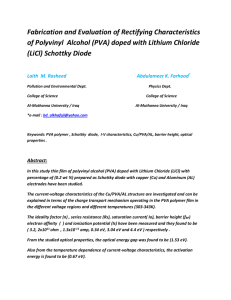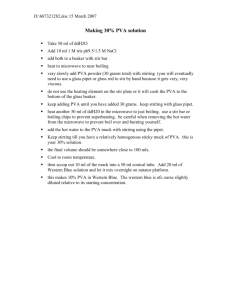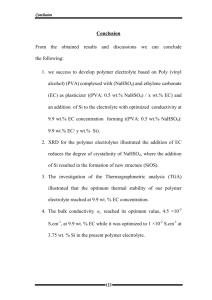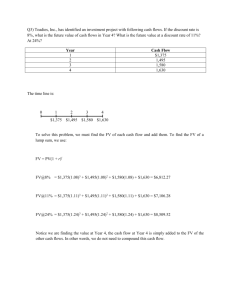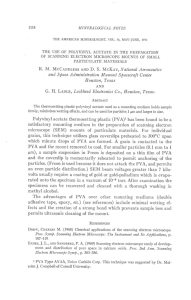International Journal of Application or Innovation in Engineering & Management... Web Site: www.ijaiem.org Email: , Volume 2, Issue 10, October 2013
advertisement
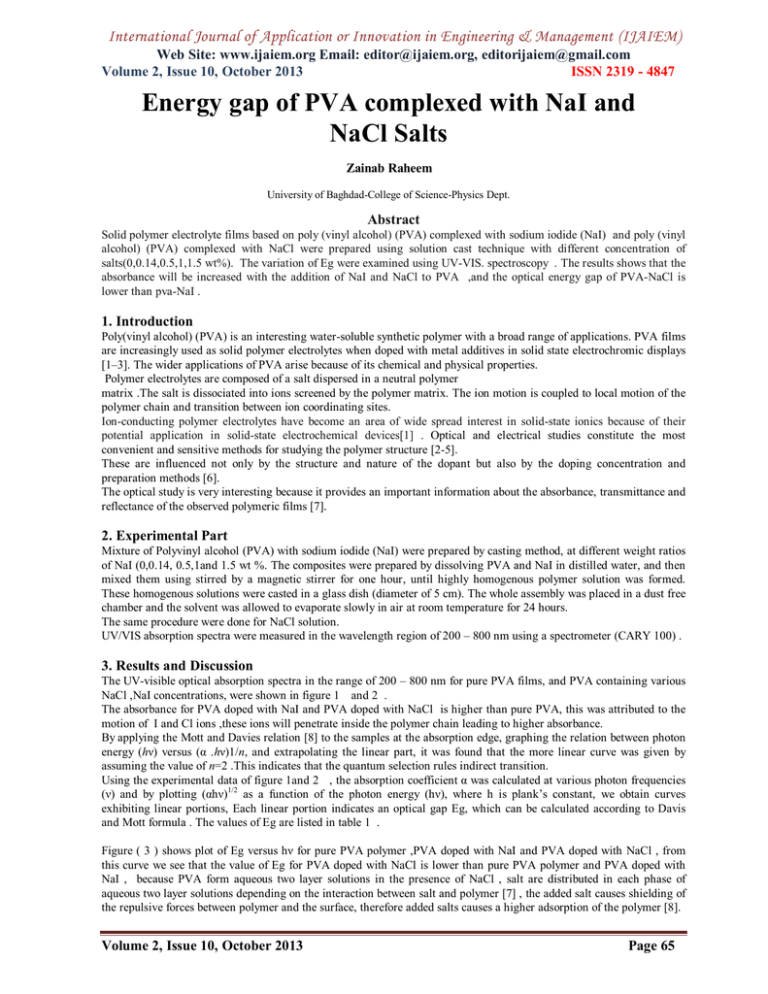
International Journal of Application or Innovation in Engineering & Management (IJAIEM) Web Site: www.ijaiem.org Email: editor@ijaiem.org, editorijaiem@gmail.com Volume 2, Issue 10, October 2013 ISSN 2319 - 4847 Energy gap of PVA complexed with NaI and NaCl Salts Zainab Raheem University of Baghdad-College of Science-Physics Dept. Abstract Solid polymer electrolyte films based on poly (vinyl alcohol) (PVA) complexed with sodium iodide (NaI) and poly (vinyl alcohol) (PVA) complexed with NaCl were prepared using solution cast technique with different concentration of salts(0,0.14,0.5,1,1.5 wt%). The variation of Eg were examined using UV-VIS. spectroscopy . The results shows that the absorbance will be increased with the addition of NaI and NaCl to PVA ,and the optical energy gap of PVA-NaCl is lower than pva-NaI . 1. Introduction Poly(vinyl alcohol) (PVA) is an interesting water-soluble synthetic polymer with a broad range of applications. PVA films are increasingly used as solid polymer electrolytes when doped with metal additives in solid state electrochromic displays [1–3]. The wider applications of PVA arise because of its chemical and physical properties. Polymer electrolytes are composed of a salt dispersed in a neutral polymer matrix .The salt is dissociated into ions screened by the polymer matrix. The ion motion is coupled to local motion of the polymer chain and transition between ion coordinating sites. Ion-conducting polymer electrolytes have become an area of wide spread interest in solid-state ionics because of their potential application in solid-state electrochemical devices[1] . Optical and electrical studies constitute the most convenient and sensitive methods for studying the polymer structure [2-5]. These are influenced not only by the structure and nature of the dopant but also by the doping concentration and preparation methods [6]. The optical study is very interesting because it provides an important information about the absorbance, transmittance and reflectance of the observed polymeric films [7]. 2. Experimental Part Mixture of Polyvinyl alcohol (PVA) with sodium iodide (NaI) were prepared by casting method, at different weight ratios of NaI (0,0.14, 0.5,1and 1.5 wt %. The composites were prepared by dissolving PVA and NaI in distilled water, and then mixed them using stirred by a magnetic stirrer for one hour, until highly homogenous polymer solution was formed. These homogenous solutions were casted in a glass dish (diameter of 5 cm). The whole assembly was placed in a dust free chamber and the solvent was allowed to evaporate slowly in air at room temperature for 24 hours. The same procedure were done for NaCl solution. UV/VIS absorption spectra were measured in the wavelength region of 200 – 800 nm using a spectrometer (CARY 100) . 3. Results and Discussion The UV-visible optical absorption spectra in the range of 200 – 800 nm for pure PVA films, and PVA containing various NaCl ,NaI concentrations, were shown in figure 1 and 2 . The absorbance for PVA doped with NaI and PVA doped with NaCl is higher than pure PVA, this was attributed to the motion of I and Cl ions ,these ions will penetrate inside the polymer chain leading to higher absorbance. By applying the Mott and Davies relation [8] to the samples at the absorption edge, graphing the relation between photon energy (hν) versus (α .hν)1/n, and extrapolating the linear part, it was found that the more linear curve was given by assuming the value of n=2 .This indicates that the quantum selection rules indirect transition. Using the experimental data of figure 1and 2 , the absorption coefficient α was calculated at various photon frequencies (ν) and by plotting (αhν)1/2 as a function of the photon energy (hν), where h is plank’s constant, we obtain curves exhibiting linear portions, Each linear portion indicates an optical gap Eg, which can be calculated according to Davis and Mott formula . The values of Eg are listed in table 1 . Figure ( 3 ) shows plot of Eg versus hν for pure PVA polymer ,PVA doped with NaI and PVA doped with NaCl , from this curve we see that the value of Eg for PVA doped with NaCl is lower than pure PVA polymer and PVA doped with NaI , because PVA form aqueous two layer solutions in the presence of NaCl , salt are distributed in each phase of aqueous two layer solutions depending on the interaction between salt and polymer [7] , the added salt causes shielding of the repulsive forces between polymer and the surface, therefore added salts causes a higher adsorption of the polymer [8]. Volume 2, Issue 10, October 2013 Page 65 International Journal of Application or Innovation in Engineering & Management (IJAIEM) Web Site: www.ijaiem.org Email: editor@ijaiem.org, editorijaiem@gmail.com Volume 2, Issue 10, October 2013 ISSN 2319 - 4847 Table 1 : the energy gap values for pure PVA , PVA-NaI and PVA-NaCl salts with different concentrations materials Eg ( eV) Eg ( eV) Pure PVA 5.05 PVA-NaI 2g- 0.14g wt% 4.8 PVA-NaCl 2g- 0.14g wt% 4.6 PVA-NaI 2g- 0.5g wt% 4.75 PVA-NaCl 2g- 0.5g wt% 4.6 PVA-NaI 2g- 1g wt% 4.6 PVA-NaCl 2g- 1g wt% 4.55 PVA-NaI 2g-1.5g wt% 4.55 PVA-NaCl 2g- 1.5g wt% 4.48 4. Conclusions The energy gap for pure PVA is higher than for PVA doped with salts, adding of salt to PVA lower the energy gap, and PVA –NaCl have lower energy gap than PVA-NaI. 5-References [1] P. Balaji Bhargav & V. Madhu Mohan & A. K. Sharma &V. V. R. N. Rao,Structural and electrical studies of sodium iodide doped poly(vinyl alcohol) polymer electrolyte films for their application in electrochemical cells, Ionics (2007) 13:173–1780. [2] C. Uma Devi, A.K. Sharma, and V.V.R.N. Rao,"Electrical and optical properties of pure and silver nitrate-doped polyvinyl alcohol films", Material Letters 56, 167-174 (2002). [3] F.M. Reicha, M. Ishra, and M.M. Gabr, "On the physical and electrical properties of poly propenal prepared by electropolymerization technique", J. of Phys. and Chem. of Sol. 64, 1157-1161 (2003). [4] T. Kimura, and M. Kajiwara, "Electrical properties of poly(n butylamino) (di-allylamino) phosphazene", Journal of Material Science, 33 (11),2955-2959 (1998). [5] V. Raja, A.K. Sarma, and V.V.R. Narasimha Rao,"Optical properties of pure and doped PMMACOP4VPNOPolymer films", Materials Letters, 57 (30),4678-4683 (2003). [6] A. El-Khodary, A.H. Oraby, and A.E. Youssef,"The effect of AgNO3 filler on the physical properties of polystyrene films", International J. of Mat. Sci. 3(1), 11-24 (2008). [7] S.H. Deshmukh, D.K. Burghate, S.N. Shilaska, and P.T. Deshmukh, "Optical properties of polyaniline doped PVCPMMA thin films", Indian J. of Pure and Appl. Phys. 46, 344-348 (2008). [8] N.F. Mott and A.E.Davies, oxford: Clarendon Press, 1977. 5 PVC pure abs 4 nacl.1 nacl.5 3 nacl1 2 nacl1.5 1 0 200 250 300 350 400 wavelength (nm) Figure 1: absorbance of pure PVA and PVA-NaCl as a function of wavelength 5 PVC pure 4 abs nai.1 3 nai.5 2 nai1 nai1.5 1 0 200 250 300 350 400 wavelength(nm) Figure 2: absorbance of pure PVA and PVA-NaI as a function of wavelength 5.1 5 Eg( eV) 4.9 4.8 pva-nai 4.7 pva-nacl 4.6 4.5 4.4 0 0.2 0.4 0.6 0.8 1 1.2 1.4 1.6 percent weight of salt Figure 3 : Eg values as a function of percent weight of salt Volume 2, Issue 10, October 2013 Page 66
